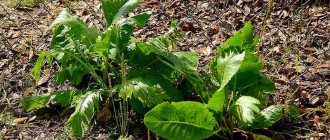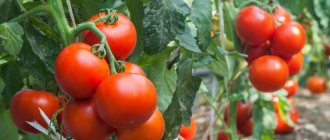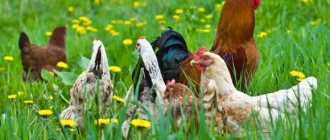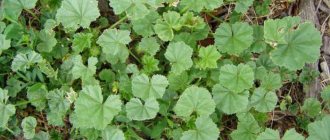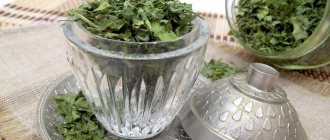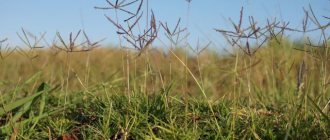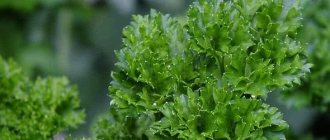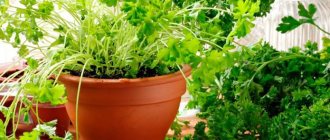The main distinguishing characteristics of parsley
Parsley is a small herb of the Apiaceae family that produces seeds in the second year of the growing season. From the Latin name of the species Petroselinum is translated as “mountain celery.” It is grown in a one- or two-year culture. The root is taproot, cylindrical. The leaves are dissected two or three times, have a bright green color with a characteristic shine on the outside.
Curly parsley
Petroselinum crispum (P. curly) is the only representative of its species. Has three varieties:
- common (Petroselinum crispum var. crispum);
- Neapolitan (Petroselinum crispum var. Neapolitanum);
- root (sugar) (Petroselinum crispum subsp. Tuberosum).
In the first year of development, the plant forms a rosette of leaves and a root, in the second year of vegetation - an erect, branched stem from 30 cm to 1 m with a peduncle. The inflorescences are complex umbrellas with small white or yellowish-green flowers. The seeds of the plant are used for propagation. Essential oil is obtained from them, which is used in cosmetology and the perfume industry...
Parsley root
Neapolitan parsley
It is grown for greens, root crops, and in mixed culture.
Curly parsley is used fresh, dry or salted. This is one of the few spices that retains its aroma after heat treatment.
The peculiarity of the plant is its sweet, spicy aroma with a tart taste, which is imparted by the essential oil. All parts of the plant contain it in one quantity or another.
- The highest percentage is in seeds (up to 7%).
- Leaves and stem contain up to 0.3%,
- roots – up to 0.1% apiol (parsley camphor).
On a note .
Essential oil of curly parsley is included in the list of narcotic substances in Russia. Government decree prohibits its use in the production of dietary supplements.
Definition and brief botanical description
Parsley
This species is a biennial plant of the Parsley genus of the Apiaceae family. It has a spindle-shaped root, thinning towards the end, and an erect, highly branched stem.
A characteristic feature of parsley is its leaves. Their general shape is close to triangular, but the edges are so strongly cut that it is quite difficult to notice.
Parsley usually blooms in mid-summer in the second year of cultivation . The flowers are yellow-green and form an umbrella. The fruits that appear are oblong, close to ovoid in shape.
Celery
This plant also belongs to the umbrella family, but its genus is different - Celery itself.
This is a tall (up to a meter) biennial plant. Like parsley, in the first year it forms only a rosette of leaves, and blooms in the second year. After flowering, it forms a rounded fruit close to double with characteristic thread-like ribs on each half. Celery leaves are closer in shape to a diamond , and although the edges are jagged, the cuts are sawtooth-shaped, not going as deep into the leaf blade as in parsley.
Herbs similar to parsley
When buying parsley for greens, it can be confused with some herbs. This is not surprising, because they all belong to the same family. In addition to parsley, cilantro, celery, and lovage have dissected leaves of a similar shape. Spicy plants can both smell and stink at some stages of development.
Externally, a bunch of cilantro is difficult to distinguish from parsley
Cilantro
Cilantro is a green herb that is most often confused with parsley. Their leaves are very similar. On a shelf in a supermarket you can't tell at first glance. To the touch, cilantro leaves are more delicate and small. You can distinguish greens by the aroma exuding from the mashed stem.
Plants in the garden bed are easy to identify in the second year of life. Coriander seeds are round, larger than those of parsley. The stem is less leafy, the flowers are pink.
On a note . Cilantro is the colloquial name for coriander (Coriándrum sátivum). its leaves are used as herbs, its seeds are a well-known spice. In some places, cilantro is called Chinese parsley, sowing kishnets, kishnishi, kinji, shlendra, kashnich, kolyandra.
Cilantro is a source of many beneficial substances that has a beneficial effect on the human body. It contains a large amount of vitamin K, which affects the overall composition of the blood, normalizes the functioning of the excretory system and liver, and can minimize the effect of certain types of toxins.
It differs from parsley in its unpleasant odor during flowering. Because the plant smells like bedbugs, it is not popular on European tables and is most often called a herb similar to parsley with an unpleasant odor.
Celery stalks are widely used for making fresh juice.
Celery
Celery is a herb from the Apiaceae family. The most famous vegetable plant is celery (Apium graveolens) - an aromatic plant with a negative calorie content.
Cultivated as an annual or biennial plant. The leaves are twice pinnately dissected. It has a tall (up to 1 m) branched stem, the root is very thick and spherical. The inflorescences are an umbrella with greenish-white flowers.
Juicy green stems are used to prepare fresh juice, a trend in recent years. Seasonal greens not only replenish the body with nutrients, but also help get rid of extra pounds. Celery is number one on this list.
Leaves, stems and roots are used for food. The latter are valued for their low calorie content (half that of potatoes) and unusual sweetish taste. Soups with roots do not differ in taste from meat broths. The leaves have a specific aroma and are used as a seasoning. The stems are juicy and crispy - the basis of freshly prepared drinks. They act as an antiseptic, remove toxins, and enhance the breakdown of cellulite deposits.
Lovage
Almost every garden grows a spice that vaguely resembles parsley.
Lovage is the name of a genus of perennial grass of the Apiaceae family, which is represented by the species Lovage (Levisticum officinale). In Russian it has many synonyms: love-grass, lyubets, lyubchik, love and love potion. It grows in the wild only in Iran and Afghanistan, and is cultivated everywhere. It has a powerful stem up to 2 m high, branched in the upper part. The root system is developed, with a thick root. The leaves are large, shiny, dissected into obovate or diamond-shaped lobes. The flower is small with a yellow tint.
A distinctive feature is the aroma with the smell of celery, but more pungent and spicy. Lovage has a bitter-salty taste. Fresh parts of the plant are used to flavor confectionery products, drinks, and marinades. Green oil, salad, and meat and fish dishes are prepared from the leaves and stems. Lovage is added to sauces, side dishes, soups, and vegetable dishes.
Lovage
In dietary nutrition, the plant is on a par with dill and basil.
Widely used as a cosmetic and pharmacological agent, it is a common and safe counterpart to Petroselinum crispum.
Spicy lovage
People's Councils
To prevent the wrong greens from ending up on your home table, you just need to be careful. Popular wisdom does not give specific recommendations on how to accurately identify the right herb. But if you try, the likelihood of error will be minimized.
On a note! If parsley, cilantro, and celery are planted in the garden plot, it will not be superfluous to mark the beds with each of the plants. It is best to place them in different parts of the garden or vegetable garden.
If the herbs are purchased rather than grown yourself, the likelihood of buying the wrong thing is slightly higher. Before the eyes of the buyer is grass that has undergone pre-sale preparation: cut to the same length and tied into bunches. In such a situation, if the seller cannot guarantee that he has a good understanding of greens, it is not advisable to focus only on the appearance of the crop. But even in this case, there is a solution - you can simply taste the grass. There is no need to be afraid to do this. It is unlikely that the poisonous twin of culture will be on the counter.
A house plant similar to parsley (common chervil)
Vaguely reminiscent of parsley is another home plant - common chervil (international name Anthriscus Cerefolium Hoffm) - a herbaceous annual with more elongated leaves. The plant originates from the Caucasus and Central Asia, but today is widespread in the southern and middle latitudes of Russia, Europe, Moldova, Crimea, the USA, Australia and the New Zealand archipelago.
In Russian it has synonyms: snedok, zhurnitsa, kupyr.
Valued for its aromatic and taste qualities. The smell is reminiscent of anise, the taste is a cross between parsley and parsnip. Widely used in French cuisine. Chervil leaves go well with all green herbs. A characteristic feature is the ability to enhance all tastes. Add to dishes at the end of cooking or before serving.
Chervil
Chervil openwork
Greens are used fresh or frozen. Dried leaves lose their aromatic properties.
Oregano
Oregano is a member of the same family as mint, although it has a strong, pungent flavor.
It can be used to replace parsley as a garnish, fresh or dried, in cooking, although you should use less oregano than parsley as it has a much stronger flavor.
Oregano contains a powerful antibacterial compound called thymol, which can kill harmful bacteria, according to some test-tube and animal studies ().
Weed similar to parsley
Weeds and plants similar to parsley can be poisonous. These are buttercup, poisonous vekh, corysh, popularly referred to as Dog parsley, Fool's parsley, Fool's chervil, Poisonous parsley or Znoiha. The genus is represented by Common Kokorysh (Aethusa cynapium) - a one- or two-year-old poisonous plant. It has a branched stem empty inside, growing to a height of 80-100 cm. The leaves are deeply pinnate, with a triangular outline. The leaf blades are diamond-shaped with incised lobes.
The fruit is wide ovoid with keel ribs.
The plant is odorless. It differs from parsley in the waxy coating on the top of the leaf and the structure of the wrapper. It is found in all regions of the European part of Russia on light, rich soils of wastelands, near dwellings, in gardens and in summer cottages.
- Kokorysh
The toxic properties of the plant are not supported by scientific research, so in the literature there is information about both the toxicity of the cory and its complete harmlessness. Some sources (English Wikipedia) provide information about the toxic effects of Znoika on the gastrointestinal tract of humans and animals, manifested by inflammation of the mucous membranes. Dried fool's chervil is not poisonous as some of the toxins are destroyed by drying.
Are celery and parsley the same thing?
Celery Like other vegetable crops, celery contains vitamins, especially C, macro- and microelements, and a lot of fiber. The juice of the plant is useful to take for dermatitis, urticaria, diathesis, malaria, diabetes (1 teaspoon 3 times a day 20-30 minutes before meals). Celery juice is recommended for obese people with metabolic disorders and fatigue. Due to the high content of vitamins C, B1, B12, PP in celery, as well as elements such as iron, sulfur, calcium, this drug normalizes metabolic processes quite quickly. To prevent metabolic disorders and high fatigue, you should take 1-2 teaspoons of celery juice 3 times a day 30 minutes before meals (up to 100 ml per day in total). For those suffering from allergic processes, traditional doctors recommend: 1 tbsp. pour a spoonful of chopped celery roots into 1.5 liters of boiling water, leave, covered, for 4 hours, strain. Take 1 tbsp. spoon 34 times a day 30 minutes before meals. To treat frostbite, boil 150-200 g of dried celery in 1 liter of water, cool and keep the frostbitten limb in the broth until the solution is completely cooled. After this, pour cold water over the limb and lubricate the frostbitten area with goose fat.
Wild herb similar to parsley (creeping buttercup)
In the wild you can find a herb similar in appearance to parsley.
Creeping buttercup is a representative of the Ranunculaceae family, growing in wet meadows, forest bolts, vegetable gardens and summer cottages located in the lowlands. Perennial, has a thick, succulent, pubescent creeping stem with thickened internodes.
The lower leaves are tripartitely divided, unequally toothed, on petioles. The upper ones are seated on the stem, tripartite, elongated.
The flowers are relatively large (diameter 2-3 cm), regular in shape, with five petals of bright yellow color, collected in inflorescences.
Ranunculus flower
Creeping buttercup leaves
Creeping buttercup (Ranunculus repens) is a poisonous weed. When eaten in large quantities, it causes severe poisoning and death of domestic animals. After drying, the weed loses its toxic properties.
Basil
Basil is a plant with bright green leaves. It is a key element of Italian dishes and the main ingredient in pesto, a sauce made from herbs, olive oil and pine nuts.
Basil is rich in vitamin K - just 5 leaves contain 9% of the RDA for this vitamin. Vitamin K can help strengthen bones and promote normal blood clotting (,).
Basil is an excellent substitute for parsley when used as a garnish. However, to improve flavor, it should only be used as a substitute for dried or fresh parsley in Italian dishes.
Weed classification
Weeds are classified according to many characteristics. They are mainly divided into minors and perennials. The difference between these groups lies in the method of reproduction: juvenile weeds reproduce only by seeds, while perennial weeds can produce shoots, that is, reproduce vegetatively. You can get rid of perennial weeds only by completely destroying their root system.
Depending on their “nutrition,” weeds are divided into parasitic and non-parasitic. The former cannot exist without a carrier plant, while the latter can grow and develop independently.
Weeds are classified according to many characteristics
Disease Prevention
Avoiding problems is better than looking for ways to solve them. Simple rules will help prevent crop loss:
- Heat treat the seeds before planting (temperature +45-50°C).
- Collect and remove plant debris at the end of the season.
- Weed and loosen the beds. Apply potassium and phosphorus fertilizers for fertilizing.
- Sow the crop in drained, ventilated areas. Thin out plants.
You can grow parsley all year round, using a heated greenhouse or apartment window sill in winter. This process is simple and inexpensive, and there will always be a bouquet of vitamins on the table.
Carrot tops
Carrot tops are another unexpected substitute for parsley as a garnish. Although some consider it inedible, it is completely safe to eat and has several beneficial properties.
Like carrots, carrot tops contain ample amounts of vitamin C, a powerful antioxidant that can help strengthen your immune system (, ).
However, carrot tops can have a bitter taste, so it is not recommended to use them as a substitute for fresh or dried parsley in various dishes.
What does a stink bug look like?
The stink bug, or black-whiskered stink bug, as well as the forest bug (lat. Carpocoris purpureipennis) is a species of bugs widespread throughout Eurasia. They live in garden plots, meadows, forests and roadsides.
The beetle has a body up to 2 cm long. Shades of color can be very different: from green to gray and reddish-brown. But the most common is the marbled beetle, which we see in our areas. You can see what the insect looks like in the photo. Thanks to this appearance, it easily blends with plants and the environment.
The body shape resembles a pentagon with protrusions on the sides. The insect has a hard shell, under which there are wings.
Where does the bad smell come from?
Special glands located on the stomach, head and back of the body are responsible for the unpleasant odor. The secretion contains cymic acid, which is unpleasant to humans. It is believed that this is how they protect themselves from predators.
Some types of insects are capable of spraying their “stench” over several centimeters. The smell can persist for several hours, which is extremely unpleasant.
The bug releases secretions from the glands for specific reasons:
- scare away enemies and warn of danger;
- attract females for mating and drive away male competitors;
- promote food search;
- help to navigate in space.
Life cycle
The life cycle of the stink bug includes mating, reproduction, feeding from spring to late autumn. In winter, the insect goes into suspended animation. Mating season begins in spring.
In the photo there is a stink bug laying eggs
The female breeds her offspring on the inside of the leaves. She can lay up to 40 eggs at one time. After 2 weeks, larvae appear that resemble adults. The offspring begins to actively feed, destroying plants. While growing up, they go through 5 molts.
How long does the black-whiskered stink bug live?
Average life expectancy is 1-1.5 years. The timing of the development of an individual from egg to adulthood largely depends on environmental conditions. If they are favorable, within a month an adult bug will grow from the egg. Sometimes this period lasts up to 2-3 months.
What does the forest bug eat?
The beetle has a piercing-sucking mouthparts. With its sharp proboscis it pierces the plants and sucks the juice out of them. The smell is not the only feature due to which humanity shows hostility towards this type of insect. The stink bug causes a lot of damage to agricultural lands and summer cottages. The secret lies in the feeding characteristics of the pest.
In the photo, the shield bug is eating raspberries
The bug loves young shoots and plants with soft stems. He puts his proboscis into them and sucks out the juice, which is why the culture dies. The insect especially loves raspberries. So if you notice a shield bug on your property, it’s time to start fighting them. In a house or apartment, individuals are harmless. Their appearance does not threaten anything except an unpleasant odor.
Do stink bugs bite?
The insect does not pose a threat to humans. Many residents of private houses and apartments, seeing an uninvited guest in their room, wonder whether this beetle is dangerous and whether its bite can cause illness.
Fortunately, stink bugs do not bite people, so there is no need to be afraid of them. Their mouthparts are adapted for sucking, but not for biting. And they don’t drink blood, like their closest cousins bed bugs and mosquitoes. In houses, they are more likely random guests who accidentally flew through the window or arrived along with herbs, fruits or vegetables from the garden.
Pets are especially affected by the stink bug. Bedbugs do not cause significant harm to cats or dogs, but due to the odorous secretion, pets may salivate for a long time.
If you want to help your pet, rinse its mouth with warm running water and monitor its condition for several days.
If a cat refuses to eat or feels unwell, this is most likely the consequence of swallowing an insect. In this case, contact your veterinarian.
What does celery taste like when cooked?
After cooking, celery stalks taste like zucchini . Root vegetables are boiled or fried; during heat treatment, their taste becomes less pronounced, similar to potatoes.
Methods of use in cooking
The list of dishes that can be prepared from celery includes salads, soups, main courses, seasonings, sauces, and green smoothies. Greens and petioles are most often consumed fresh: they are used to prepare smoothies, vitamin-rich salads with the addition of fruits and vegetables. Root vegetables are used as a substitute for potatoes; as a side dish for a meat dish, puree is made from boiled potatoes and celery in a 1:1 ratio.
Smell
The main reason for the repulsive unpleasant odor emanating from the stink bug is a special secretion produced by the odorous glands. They secrete substances that contribute to the spread of an unbearable stench for humans. In forest bugs it is cymic acid. The glands that produce secretions with an unpleasant odor are multifunctional. Depending on the concentration of the secreted substance, stink bugs can use it as the following tools:
stink bug
- signal with your scent the approach of danger and scare away enemies;
- attract a partner for mating;
- scare away competing males;
- help to navigate in space by smell, find fellow tribesmen and make long transitions;
- promote efficient foraging.
On a note!
Stink bugs do not suffer from their own stench, but these secretions are dangerous for surrounding insects. They can cause paralysis, spasms, and in the worst case scenario, death of the enemy.
A bug stinks the most when you crush it. The odorous secretions of street parasites create an unbearable stench due to the processing of the juices of the plants on which they feed. For forest bugs, their scent is a reliable weapon against a large number of enemies. At the moment of immediate threat or approaching danger, the stink glands intensively produce a special secretion. Physical damage to the insect only intensifies the smell, as the odorous substance is squeezed out of the ducts in which it is formed and stored. This contributes to the fact that “light pheromones” are replaced by an intense poisonous aroma, absolutely safe for humans.
Many people are interested in the question of what insects smell like bedbugs. All representatives of this type of insect, to a greater or lesser extent, have a specific odor. Pungent odors are emitted by almost all types of agricultural pests, as well as other herbivores and carnivores:
- shield bugs - two-toothed, berry, red-legged, green and striped;
- northern cruciferous bug;
- harmful turtle; bug turtle
- water strider;
- belostoma;
- American stink.
To this list of insects with intense secretion of secretory fluid, you can add the well-known soldier bug, and the birch bug also belongs to them. A large number of different insects that fly and crawl into apartments and houses emit odors similar to stink bugs. These can be completely harmless insects - weevils, mucoeds, betilids - relatives of ants and others.
Grass that smells like bedbugs
It’s a surprising thing, but this seasoning, so beloved by many, especially in Caucasian cuisine, actually smells like bedbugs. Moreover, one of its names – “bedbug plant” – already speaks for itself. We are talking about a spicy vegetable crop - cilantro or coriander. This annual plant gets its name from the Greek "koris", which means "bug".
If you lightly mash young greens or unripe cilantro fruits in your hands, your palms will retain the specific (bedbug) aroma of the seasoning for a long time. And yet this herb occupies a very honorable place among culinary specialists all over the world. There is no secret here - in combination with other spices, especially garlic, this plant acquires an excellent taste.
But why cilantro smells like bedbugs is easy to explain. Its juice contains the same aldehyde substance (trans-tricedenol-2), which is also found in insect secretions. When coriander is dried, its seed is filled with a pleasant cool pungency and subtle aroma, as the chemical component completely evaporates. With the help of decyl aldehyde, the green seasoning is protected from insect pests; when dried, this need disappears along with the odorous weapon.
Weeds that are used in folk medicine for treatment
Many weeds are used in folk medicine. Of the above, medicinal drugs include the following:
- wheatgrass - due to the presence of silicic acid, it is used in the treatment of bronchi, rheumatism, gout and to improve metabolism;
- thistle - heals the liver and enhances sexual activity;
- plantain - heals wounds without allowing suppuration;
- clover - helps to dissolve lumps in mastopathy.
Ivy bud, burdock, dandelion and dozens of other weeds have medicinal properties.
Cornflower blue
Found only in soil containing crushed stone. Reproduces only by seeds. Cornflower flowers contain brevicepsin, which has a pronounced vasodilating effect, and is used as a mild diuretic and laxative for gastrointestinal diseases (in collections) and in home cosmetology.
Nettle
The leaves are rich in ascorbic acid and carotene. Nettle has a hemostatic, anti-inflammatory and choleretic effect, restores strength, improves blood composition (increases the number of red blood cells and reduces the amount of sugar), normalizes fat metabolism. The seeds are useful for men to increase potency.
Horsetail
Used as an anti-inflammatory and hemostatic agent. Horsetail reduces blood pressure, stimulates the adrenal cortex, and helps eliminate lead from the body. When used as a diuretic, potassium is not washed away. Contains silicon, so decoctions of raw materials help improve hair growth.
knotweed
Flowers and the top 30-40 cm of the plant are used. Most often, knotweed (knotweed) is used to crush kidney stones and remove them, as well as excess salts in the urine. The weed is useful for women's health: for bleeding after miscarriages and childbirth, for iron deficiency anemia as a result of heavy menstruation, for increasing the tone of the uterine walls and restoring reproductive function. Knotweed leaves contain pectin, which removes poisons from the body.
What is the danger to plants?
The beetle's diet is based on plant sap. The bug poses a threat to agriculture. After damage by insects, all seedlings stop developing and then die completely. In a short period of time, the stink bug can destroy the entire field.
The main cause of plant death is the poison that the beetle injects when sucking out the juice. The insect quickly gets used to most chemicals. Getting rid of the pest will not be so easy. Therefore, the fight must begin as early as possible. Otherwise, you will have to constantly change the drugs used.
Affected leaves begin to turn black. The whole plant becomes covered in spots. The inflorescences disappear. Growth stops. The fruits will not appear.
Creeping wheatgrass
Creeping wheatgrass (popular name - dandur) is a grass weed. If it appears in the garden, emergency measures must be taken. It is not for nothing that, translated from Latin, the plant is called “fire of the fields.”
Wheatgrass has very long roots, up to 15 meters, similar to cords, thanks to which it draws water from the soil, quickly takes all nutrients, depletes the soil and displaces other plants.
It is almost impossible to completely uproot it, only with the help of deep digging. It grows everywhere and does not freeze. In wheat fields it can reduce yields by up to 500 kg per hectare.
